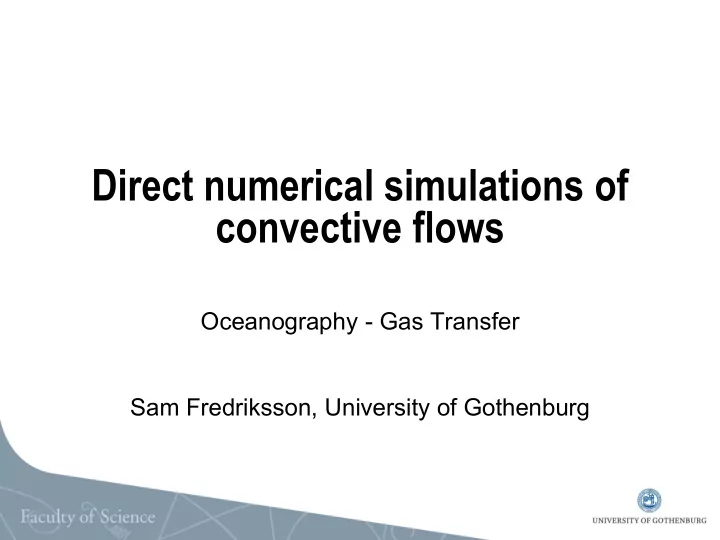

Direct numerical simulations of convective flows Oceanography - Gas Transfer Sam Fredriksson, University of Gothenburg
Outline of this presentation • Aim with this presentation • Background • Route forward • Work so far Carbon Cycle – IPCC (2007)
How are CO 2 fluxes determined? Typically: 1.CO 2 concentration in surface water (pCO 2 ) 2.Flux model: F = k ( C aq – C eq ) 3.Piston velocity/gas transfer koefficient ( k ) calculated from average wind speed at 10 m height.
D. Bade 2009, Encycl. of Inland Waters
Surfactant influence of flow field and gas transfer Clean Oley alcohol II k as a funct. of time Surface velocity (surfactant concentration cholesterol) Surface vorticity Surface divergence McKenna 2000
Gas exchange research strategy Forming a group of researchers Gas exchange and concentration measurements Wind measurements Turbulence measurements Infrared camera recording Numerical modeling
Route forward numerical simulations General • DNS (Direct Numerial Simulations) with OpenFoam • DNS with convection • DNS with surface shear • DNS with surfactant • LES (Large Eddy Simulations) • Waves …
Route forward numerical simulations Lars Davidsson et al. ”DNS of plane vertical channel with and without buoyancy”, Turbulence, Heat and General Mass Transfer, 2003 • DNS with OpenFoam 1.4 1.2 • DNS with convection 1 0.8 • DNS with surface shear Umean/Ubar Umean 0.6 _Lada/Ubar • DNS with surfactant 0.4 0.2 • LES/DNS moving surface 0 0 0.2 0.4 0.6 0.8 1 1.2 1.4 1.6 1.8 2 • Waves … 0.2 0.18 0.16 0.14 0.12 urms/Ubar vrms/Ubar 0.1 wrms/Ubar urms_Lada/Ubar 0.08 urms_Lada/Ubar wrms_Lada/Ubar 0.06 0.04 0.02 0 0 0.2 0.4 0.6 0.8 1 1.2 1.4 1.6 1.8 2
Route forward numerical simulations General Robert Handler: ”Direct numerical simulations of free convection • DNS with OpenFoam beneath an air-water interface at low • DNS with convection Rayleigh numbers”, Physics of Fluids, 2003 • DNS with surface shear • DNS with surfactant • LES/DNS moving surface • Waves …
Computational domain Evaporation
Boussinesq formulation Momentum and Continuity �� �� � U ∙ � U � � 1 �� � ν � � � � �� � � � � � � � � ∙ U � 0 Linear approximation of density � �� � � � � � 1 � � � � � � , � � � �� � � � � Temperature field is governed by a convection-diffusion equation given by �� �� � U ∙ � T � � � � T � S
Temperature field, Ra q ≈ 5x10 6 0.076 m Played 10 times real time
IR-measurements at Bornö L z = 0.122 (Side = 0.17 m) Ra ~ QL z 4 ≈ 1 m Magnus Gålfalk
Surfactant - Finite Area Method - fam
Areas for investigation Analysis • Mesh convergence – it seems that there is a need for finer meshes with present formulation compared to Handler et al. • Size of computational box and mesh resolution • More thorough analysis and comparison against experiments etc. • Surfactant formulation, cyclic boundaries for fam • Find correlation between IR and gas transfer • Find a good measure/representation of the temperature field (rms, skewness, flatness, divergence etc.) • Waves etc.
Thank you
Recommend
More recommend